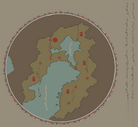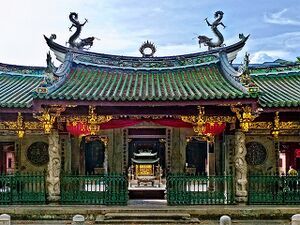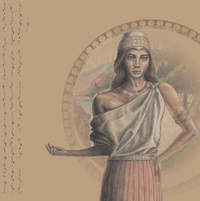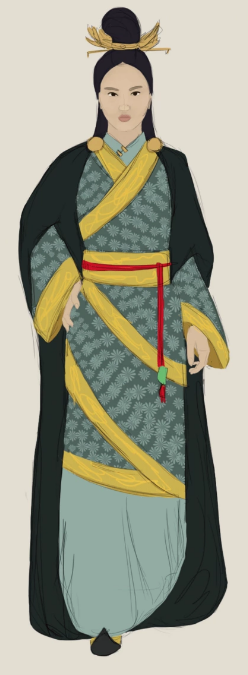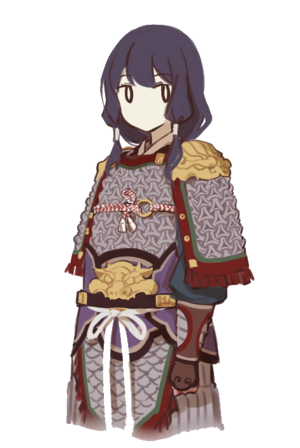Culture of Senalan
The culture of Senalan has undergone a great deal of transformations since its earliest years, from the pre-Clanmarch era to its modernized, relatively new worldview which stems from both historical and present influences originating both within the East and further beyond.
Historical overview
The predominant hypothesis regarding the origin of the Senari people is that they are the descendants of the region's indigenous Vsuyi people and later arrivals from the Degrimic Islands, which are now an overseas possession of Senalan. While Senari culture is thought to be mainly derived from the cultures of these migrating peoples, retroactively named the Senari, some mixing with the conquered Vsuyi did occur. Modern Senari are thought to have roughly 95% Senari and 5% Vsuyi ancestry, and a prominent part of their identity surrounds believed connections to specific Senari clans, though it is unlikely that the Senari of this period maintained the sort of clan system that presently exists in Senalan.
Senari culture has been influenced primarily by conflicts with fellow peoples of the Aestas Sea. During the Old Senari League, Senalan was influenced primarily by immigrants from Lethia. As a part of Yelthiss Tyri's reforms following the end of the Bleeding Years, efforts were made to purge foreign influences from Senari culture, though these campaigns have since concluded unsuccessfully.
Language
Senari is the national and only official language of Senalan, first attested in ancient works uncovered in the western Degrimih. A language isolate, the Senari language has no clear affiliation with any other language, though several regional dialects exist.
Though the Linguic alphabet is sometimes used in modern Senari, the Ssakimatar (literally "ink-speech," for its flowing nature) script is far more popular within the country. Senari is traditionally written vertically, though a horizontal script for day-to-day communication and popular literature has grown popular over the centuries.
Religion
The Four Courts are the primary religions of Senalan. Small Christian, Islamic and Ilanean minorities exist within the nation. Though they have historically been marginalized by the federal government, recent moves towards liberalization have led to protection and a relative tolerance for the so-called Pale Cults, the Senari term for non-indigenous religious movements.
The Four Courts are an umbrella term that refers to various cults that have waxed and waned in popularity over the years in Senalan. Typically focusing on the veneration of at least one of four serpent deities, each of which being associated with their own season, followers of the Four Courts attempt to develop a strong connection between humans, nature and the Heavenly Serpents. Human sacrifice was once a key aspect of worship, and it is still practiced to an extent, though it has widely been replaced by bloodletting rituals and animal sacrifice. Some still volunteer to be sacrificed in major festivals, though some activists claim that these "volunteers" receive far too much pressure to participate to be properly deemed as such.
A centralized, ultranationalist understanding of the Four Courts was popularized by Yelthiss Tyri in order to foster national unity, though later course reversals regarding its promotion and the subsequent murder of the faith's head, the Snake-Speaker, have caused this iteration of the faith to fall somewhat out of favour. Theologians and anthropologists both believe that Senalan is in the midst of a religious reformation, with a gradual return to decentralized, less ethnically-charged worship actively taking place.
Cultural chauvinism and race
A defining characteristic of the Senari national character is the popular belief in the inherent supremacy of Senari culture. Once fueled by the influence and power of the Old Senari League, the reunification of the country in 1963 was followed by a dramatically increased focus on Senari exceptionalism and their right to power.
Unlike many other nations, Senari culture has no inherent concept of race. The various peoples that invaded and settled Senalan were not what would typically be considered a single racial group, and no direct connection between race and culture developed in Senari culture. Senari tend to believe that cultural practices as opposed to race are what define a person's identity, and they have developed a strongly assimilationist worldview; they believe that all people are capable of becoming fully-fledged Senari, but also that their cultural identity is indisputably 'correct' and the only valid way to live.
Literature
Early works of Senari literature were heavily influenced by the legacy of the Hunger, a period of extreme famine and volcanic activity within the Degrimic islands shortly before the Clanmarch. These works focus on the exploits of mostly-legendary chieftains and chieftesses who eventually settled their people in what is now Senalan. Senari literature has been somewhat affected by contact with the West through Lethia, though the relative isolationism of both countries has left most Senari literature without much influence. Some literature forms of Western origin continue to be popular within the country, though many Senari believe them to have originated within Senalan.
Clans
The Senari clan system is an ever-shifting, decentralized network of familial, business and other interpersonal relationships between various groups of Senari people. Though thousands of minor clans exist, several major "umbrella clans" with some shared identities have emerged. Despite a lack of direct connection to the mythological Senari clans that are believed to have settled Senalan, the largest clans have assumed these ancient, legendary names.
Clan identity is not rigid. It is not unheard of for Senari to change their clan allegiance upwards of fifty times within their lives as their economic and personal status, friends and family change. Clan membership is mandatory to properly participate in Senari society, with exile from a clan being an effective loss of citizenship. Senari who are unable to maintain a connection with any of these cliques are cast out of their society and are widely looked down upon.
Visual arts
Senari calligraphy is considered both a form of art and literature, typically used for communicating poetry, though longer-form storytelling is also possible. Calligraphers continue to be a highly respected group within the country, with most recognized Senari clans employing a group of such individuals to present their history in a visually appealing way. It is not unheard of for some calligraphers to take dozens of attempts to write a single character, with a near-obsessive sense of perfectionism surrounding most aspects of Senari calligraphy.
Senari lacquerware is an internationally famous art form along with ceramics, some of the most coveted exports of the country since the pre-League era of Senalan. Popularized in the West through a trade connection with the Kingdom of Lethia, Senari ceramicists and lacquerware makers became enormously influential within the country as a result of the price commanded by their goods.
Traditional clothing
The national dress of the Senari is the Sentisenar, a unisex robe and cape that is traditionally made from silk, though poorer Senari have been known to use "lesser" materials such as cloth in producing their own. Hair is typically worn pinned up in some form, with long-flowing capes and veils often nearly reaching the floor. Developed centuries before the foundation of the Senari League, the wealth displayed by one's Sentisenar was and is an important signal of status and wealth in Senari society.
The denkai robe is another form of traditional Senari garb, typically worn by those of lower status in Senari society. Though the denkai is often associated with poverty, it is also held to be a symbol of strength and willingness to work, pillars of Senari identity.
Ankle-length socks and distinct, sharp-toed footwear are common in Senalan, worn by both men and women. Notions of masculine and feminine dress do not typically exist in Senari culture, and as such there are few if any gender-related expectations regarding style of dress.
Gardens
Gardening is a prominent aspect of Senari culture, influenced particularly by religious backgrounds. Senari are expected to maintain a garden of some size, ranging from a single potted plant to a large, resource-intensive piece of property. A Senari garden is often indicative of their religious beliefs. Followers of the Spring Court may tend towards blossoming, colourful and aromatic flowers evocative of fertility, while an adherent of the Winter Court might prefer solemn, strong groves of trees that are capable of resisting the frost and other ill weather.
Music
The music of Senalan is a wide term describing a number of traditional and modern styles. Though the Senari government has historically promoted domestic styles of music and discouraged listening to music that is not of Senari origin, regulations have since been lifted and Senari now enjoy a variety of music from all throughout Anteria.
Traditional Senari music is often held to have a "serpentine" quality, with its progressions often being compared to the rhythmic, unrelenting slithering of a snake.
Sports and leisure
Swordplay, known as taka, is the national sport of Senalan. A number of martial art styles are popular within the country, though those involving blades are the most widely-practiced. Large-scale leagues and tournaments with large prize pools exist for swordspeople exist in Senalan, with the sport being revered as an expression of the "warrior's spirit."
Cuisine
Senari cuisine consists predominantly of rice, seafood and various roasted vegetables. The relative longevity of many Senari is believed to be owed partly to this aspect of their diet, as well as a number of other aspects of their lifestyle. Senari cuisine has become increasingly popular throughout Anteria, though many of its dishes - particularly those featuring blood - are held by many foreigners as particularly unusual.
Popular culture
Senari popular culture describes the attitudes and concerns of their day-to-day lives, as well as their connection to popular pieces of media. Most modern Senari media developed from traditional art forms as a form of entertainment and distraction from contemporary issues, particularly those stemming from economic and political upheaval through the Great Blossoming. Senari animation has grown relatively popular worldwide, with a growing audience.
National symbols
The national animal of Senalan is the Tisi cobra, an animal which appears in many works of art, music and literature. The sun has an important religious and cultural connection to Senalan owing to their national mythology, with the star believed to be the burning remains of a cosmic egg from which the Senari initially emerged. Lotus flowers are held in particular regard in Senalan; this is believed to be an influence from the extinct Vsuyi people who were gradually assimilated into Senari culture.
